Because there is a citrus tree in almost every yard in California, we often inherit one when we move into a new house. Which kind is it? What if there’s no one around to tell you?
Here I describe how I approached figuring out the identities of a couple mystery citrus trees in my yard and in the yard of my neighbor. My goal is to show how you might discover which kind of citrus tree you have, if you’re in a position like us.
Some kind of orange?
There was a large orange tree in the yard when we moved into our house.
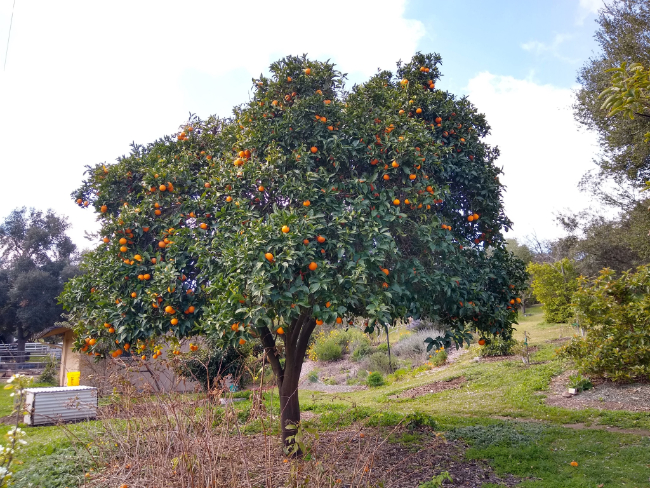
The fruit tasted good right then, in July of 2013. I knew the tree wasn’t a navel because the fruit didn’t have a navel; I figured it was a Valencia because it was ripe in the summer.
But there were two problems. The rind wasn’t as smooth as the Valencias I’d always eaten elsewhere, and the oranges almost never had a seed. I’d always known Valencias to be seedy.
I looked on the University of California, Riverside Citrus Variety Collection’s listing of Valencia-type oranges and found two seedless varieties: Delta and Midknight. The photos and descriptions for both sounded like they could be my tree and its fruit.

My best guess today is that mine is a Midknight because that is the only variety that I’ve seen being sold by nurseries to home gardeners. For example, Four Winds Growers sells Midknight Valencia trees here.
Multiple trunks and leaves in threes
Over to my neighbor’s yard. My neighbor has a tree with multiple trunks. That’s always an indicator that at least one of the trunks is rootstock.
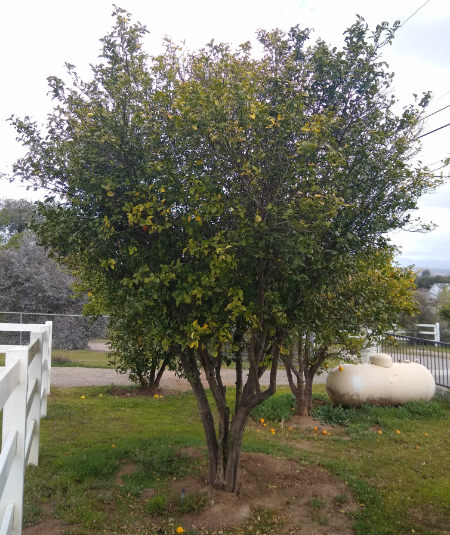
Upon a closer look, I saw that all the leaves were in groups of three. That settled it. The whole tree must be some kind of trifoliate rootstock.
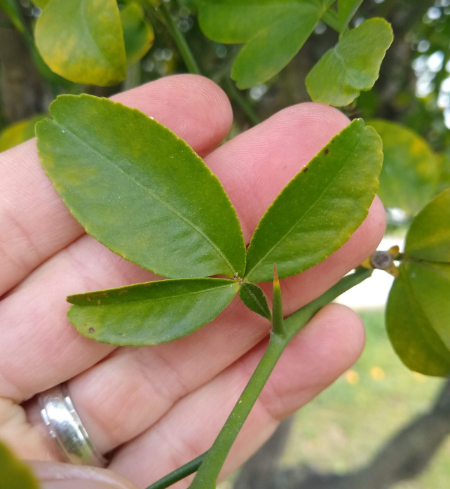
Can we figure out which? I went to the UCR CVC Rootstocks page. I knew that two trifoliate rootstocks have been most commonly used for the last couple decades so I went to their pages. Unfortunately, C-35 sounded and looked indistinguishable from Carrizo. So I went to the more detailed pages at Citrus ID. There I found two important clues. C-35 was described as having straight thorns and medium wings on the leaf petioles (stems) whereas Carrizo was described as having thorns that were absent or not persistent and narrow wings on the leaf petioles. This tree had plenty of thorns and the wings on the petioles were medium. This aligned with the tree in question. Therefore, my best guess on this tree is C-35.
Here is the fruit, by the way. It has an odd bitter taste.
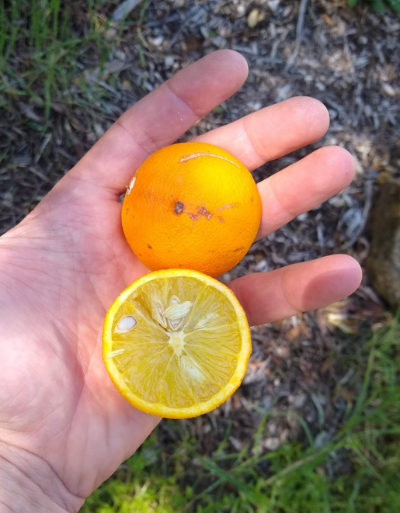
(Why does my neighbor have an entire tree of rootstock? Happens to the best of us. See my post, “Beware of rootstock suckers on citrus trees.”)
The mystery tangerine
Back to my yard. Up the hill is an old tree that is half alive, that I’ve never watered, but which still gives us some fruit each year. We’ve always referred to it as “the mystery tangerine tree.”
The fruit is smaller than an orange, and it’s sweet but tangy. There are a zillion kinds of tangerines though. How to narrow down the possibilities? The best first step is to note whether it has seeds. The mystery tangerines do.
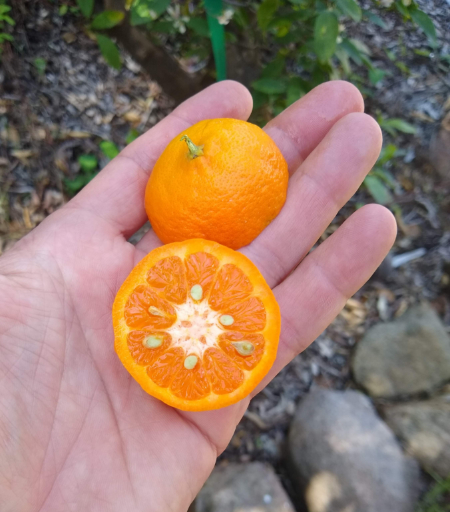
That eliminates all of the seedless varieties. Yet there remain many seedy tangerine varieties to choose from. I scanned the mandarin/tangerine listing in the Sunset Western Garden Book for matching descriptions and found a handful of potential varieties.
Then I looked up those varieties on Citrus ID, where each variety has a page they call a “fact sheet.” While perusing the photos and descriptions on those fact sheets, I kept a couple of distinguishing characteristics in mind. My mystery tangerine often has a protruding neck at the stem end. Not all mandarins have that. And my mystery tangerine peels very easily. Not all mandarins do that.
The combination of these allowed me to further eliminate the varieties Fremont, Honey, Kinnow, Afourer/W.Murcott, and Murcott.
When I hit the fact sheet for Dancy, however, the neck quality and the easy peeling quality were both there. I cross-checked with the Dancy tangerine page of the UCR CVC and found everything aligned again.
Over the years I have eaten Dancy tangerines from other trees, one at the Riverside Collection even, which has made me more confident in my guess.
Foster grapefruit?
One final tree in my neighbor’s yard. This tree’s fruit looks like grapefruit except that the fruit’s rind gets deep yellow unlike any grapefruit I’ve seen. The fruit also gets bigger than any grapefruit I know. My neighbor suspected that it might be a grapefruit called Foster.
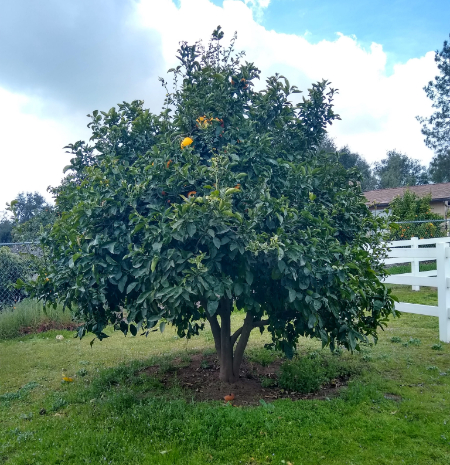
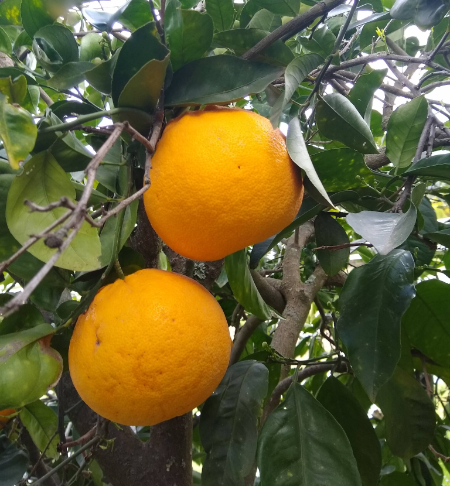
But when I looked up Foster on the UCR Citrus Variety Collection website, I found that the description didn’t match. There it is called Foster Pink grapefruit because the flesh is tinged pink. However, the flesh of my neighbor’s fruit is tinged orange. The page also described it as “sweet and tart” yet this fruit was thoroughly sweet. In fact, it was so sweet that I wondered if it were any kind of grapefruit.

A farmer friend clued me in when I shared a piece of the fruit with him and he instantly said, “This is Cocktail.”
“Are you sure?” I asked.
“This is Cocktail,” he repeated.
I looked it up when I got home. Bingo! The Cocktail photos and description on the UCR CVC page match perfectly, and it turns out that the variety is a pummelo and mandarin hybrid, which explains its size and flavor.
That’s cheating, you say. Who has a farmer friend that can just call out a citrus variety at first glance? You’re right. That was like cheating. But we have to use whatever sources are on hand.
Sources for citrus ID
Here are some sources that you might find useful when investigating your own trees:
University of California, Riverside Citrus Variety Collection
Sunset Western Garden Book (Most libraries have a copy if you don’t have your own.)
By the way, I’m open for suggestions if you think any of my above identifications are wrong. We would be happy to go back to the tasting board and reconsider.
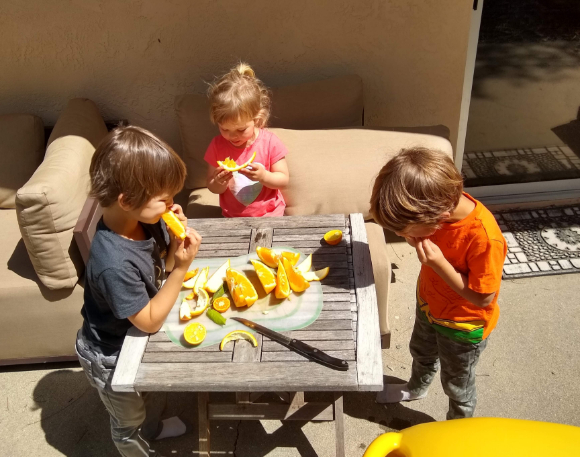
All of my Yard Posts are listed HERE
I allow no ads on The Yard Posts, instead relying on your direct support. Thank you!

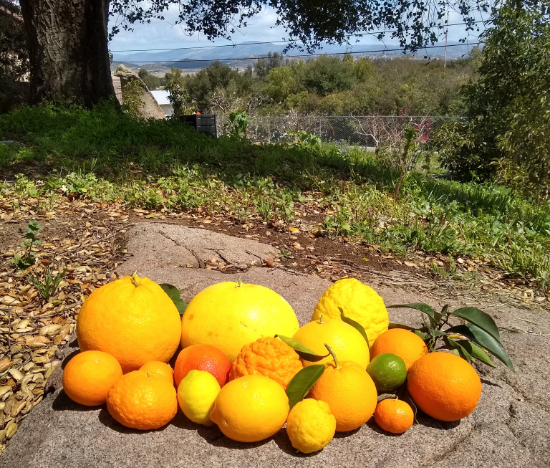


That cocktail tree produces very large very sweet fruit with none of the citrus acidity. If you look closer at that rootstock tree, there is actually one tiny twig that produced a few kumquats this winter. It was cut back a few weeks ago, it would be great it the owner cut off the rootstock and let the kumquat grow. The very large semi-lemon like citrus at the end have a single branch of lemon hanging on. Too bad, everyone should know about rootstock suckers when they buy a tree. Thanks for the post
Thanks Greg for the links and your post. I had no idea there were so many citrus. That citrus id link was overwhelming. I’ve been trying to identify a tree in my neighborhood. Its a tiny round kumquat and I think its Meiwa so I’m on the hunt for one now. I steal the fruit when I pass it in an alley and they are sweet and tangy with a tangerine bomb taste. Its addictive. Then I found out about mandarinquat. I also need a rangpur since its good for cocktails. The problem is my yard is out of space cramming avocado trees in so I’ll have to grow these along a wall. The avocados are doing great but the bees are much more interested in the citrus blossoms so I hope they visit all the trees. Looking forward to watching the avocado talk I missed. Thanks for all you do. Happy gardening ….Bita -she who carries a wooden spoon:)
Hi Bita — she who carries a wooden spoon!
Citrus intimidates me too. But on the positive side, like you said, there are so many varieties and shades of flavor that we’ll never run out of new ones to try. We’ll run out of space, yes. But we won’t run out of interest.
Hi Greg. I liked your articles as usual. On my property in North Poway, I have a couple of orange trees without navels, a white grapefruit, and a tangerine that I was trying to identify. My trees have pretty large diameter trunks, so I’m guessing they are probably over 30 years old. The info you provided will be a helpful place to start researching. Thanks for posting.
Hi, I just discovered your site, it is very useful to go through the posts and I like it. Ok, here is my struggle with two old Naval orange trees I have. From trunk-foot they appear both grafted. One has a lighter foliage and large fruit, they are sweet with a note of grapefruit. From readings I believe this can be a rootstock influence. The other tree has a much denser foliage, the fruits are not that large but have a very strong sweetish smell. This is funny because the backyard has a sweet smell in Jan. and Feb. like orange flowers but before flowering.
There are many different kind of Navel oranges and I always wonder if these are characteristics of a specific variety? So, that is what keeps me awake at night. Again, you have a nice site here, thank you
Hi Greg. Thanks again for all the information you provide. I recently moved to a new property and I have an apple tree that my neighbor says was there when he moved in 35 years ago. The fruit was ripe in June. Every time I look up old apple varieties I get overwhelmed with the amount of different varieties. Do you know of a good resource to identify apple varieties?
Hi Walter,
I would make sure it’s a grafted tree before bothering to try to identify it. If it’s a grafted tree, then you might look at these resources:
Kuffel Creek apple nursery: http://www.kuffelcreek.com/applelist.htm
Trees of Antiquity: https://www.treesofantiquity.com/collections/apple-trees
Orange Pippin: https://www.orangepippin.com/varieties/apples
The fruit being ripe in June — so early — should be key in eliminating many varieties. The first variety I’d consider is Anna, which ripens in June and has been widely planted in Southern California for many decades.
Thanks for the reply and the good information. It is a grafted tree. I wouldn’t be surprised if you’re exactly righ about it being an Anna. It matches the description from what I remember and I’ve heard they are pretty tough trees and this one has been living in temecula in a non- watered desert landscape yard for many year. There are no water sources anywhere near it. I have no idea how it has survived. Thanks again for the information.
thanks greg for the article. Currently I have a tango in my yard. In the UC paper, it said tango is harvest in mid march. I ate one yesterday and it is just plain/not ripen. Any way to improve the taste. Also, is this a good time to graft citrus now? I’m looking at a variety call Kiyomi tangor (a mandarin about the size of a baseball) from CCPP.
Hi James,
You can graft citrus any day of the year. I grafted some citrus in April last year and got good results so I’d say go ahead and get that order for Kiyomi going.
Young trees often don’t follow the normal schedule as well as older trees with lots of fruit. Sometimes the mandarins from a young tree don’t taste as good as from older trees too. Don’t worry about this a bit, yet.
Check out this post: https://gregalder.com/yardposts/dont-judge-tree-first-fruit/
thanks Greg..about the Kiyomi, I meant to say it is as big as a softball (I’ve seen one that makes a navel orange look a dwarf. It is one of parents of the famous shiranui or sumo that you see at the supermarket.
Thanks for this article. My neighbor has a Chironja (Orangello is another name). The tree comes from Puerto Rico I think and is very sweet! I tried to grow one from seed but so far no success. Any idea where I might purchase one? I run an Airbnb ( when there isn’t Covid) and everyone last year went crazy over the ones I got from my neighbor.
Hi Lynda,
I don’t know of any nursery making Chironja trees. You could make your own by buying budwood from the Citrus Clonal Protection Program. Looks like they have a couple varieties available:
https://citrusvariety.ucr.edu/citrus/chironja_3909.html
https://citrusvariety.ucr.edu/citrus/CRC4045.html
Thanks for the reply.
Can you explain how to use the budwood to produce the chironja? Do I have to have to have a branch from the Chironja tree from my neighbor to graft? Not something I’m experienced with.
Thanks
Thanks Greg,
Reading the post on citrus tree leaf reading was a real eye opener. My daughter, living in UTC SD, LaJolla lite, received two citrus trees of her choosing as a bonus for purchasing a very expensive land scape tree of considerable size, from a somewhat ruthless large nursery. The trees looked to us then as healthy and should bare fruit. The result the last two years has been lemons the size of grapefruit, rind a quarter inch think, all puckered up and non edible. The other tree what ever it is bares a small non edible possible tangerine variety. These both were root stock straight from the nursery as it now seems quite obvious. I don’t know if we will graft or just dig them out.
If the trees are still healthy then definitely graft to them. Mature trees will push new growth of the graft quickly. Just decide what your favorite citrus is and watch a grafting video on youtube.
That lemon kind of sounds like a citron. So I see why they’d be giving them out for free–citron isn’t very popular. But if you know anyone who likes to bake fruitcake, they’d love to take a few of those guys off your hands.
My cocktail grapefruit is yellow and tastes very much like a regular grapefruit. I’ve suspected that the graft I had put in years ago wasn’t a cocktail and am now wondering what it is. It’s the graft next to the Lavender gem tangelo on that tree I have with three varieties. I’ll send you a picture.
This was a great article on how many varieties are out there and how one can go about identifying what’s on any given property.
I have a general rule of thumb though…if you bought an old house and there are some old mature trees they’re probalby naval, Valencia and some sort of period specific lemon. if you have two avocados they’re probably a Hass and Fuerte. I work in a lot of old homes and it seems that the giant mature trees seem to follow this pattern, not always, but a lot.
Hi Bob,
I like your rule of thumb. Sounds very accurate from my observations too. Your fruit does look like a grapefruit. Let me know what you conclude.
So i dug into the tree yesterday to pull a grapefruit and low and behold, I pulled a cocktail grapefruit off. It seems that of the four grafts that took two are an old school grapefruit and are dominating the branch, the other two are clearly cocktail. I was very pleasantly surprised that I happened to find a new piece of fruit on this tree after all of these years. I’ll send you a picture later.
I suppose across the next week I’ll cut back some of the old school variety (but will keep it) to let light in to the cocktail so it can grow.
Hi Greg,
Thanks for the resources. I was able to finally figure my orange is a Trivota. I had long puzzled over the winter harvest, but lack of navel.
Here in west LA it’s harvest window is roughly Jan-April, though the fruit is best in March. Bloom is at its peak now too. The fruit is a little more sour than a navel (I like it this way). The fruit is a smaller, with thinner skin than a navel. It’s excellent for slicing or juicing. I’ve never had an issue with the juice going bitter. Occasionally I do get a fruit with a small navel, probably an ode to its parents. Finally it seems the harvest does fluctuate drastically from year to year. Last year we harvested nearly 1000 fruit and this year only a dozen. We’re getting a massive bloom this year that I plan to thin out to bring balance to this harvest. Thanks as always for the info.
Hi Joe,
Great detective work! I’ve never tasted Trovita; it’s interesting to hear more about it.
I bought a tree about 10 years ago that was labeled “seedless Valencia”. My neighbor has a standard Valencia. I compared the fruit of each and the taste was the same, but mine has no seeds. Greg, I wonder if they simply gave the seedless Valencia a new name to make it sell better – what do you think?
Hi Rick,
Curious thing. Wish we could know where the budwood came to make your tree or ask the nursery who made it.
Don’t give up on your citrus tree!! The one I have has proven to be extremely hardy. When I first moved down here there was a dwarf mandarin tree that must have been over-watered and half of it’s trunk flares were rotted away and for 2 years no sign of fruit but it did flower sparsely. Last summer I deprived it of water and figured I’d let it die that way and remove/replace it. I also took off all it’s leaves and smaller branches. Winter came and the rains came and the tree completely rejuvenated grew new leaves and now it’s holding about 15 mandarins that are currently very nice sized. Sure it’s not a bumper crop but it is holding fruit and maybe it will hold more if I keep taking care of it and let it grow out again.
Thanks for all your great posts! I have an orange “tree” I planted about 4 years ago & its healthy looking but it’s only grown 2-3 feet off the ground. The primary branches are growing horizontally (or even drooping back down). Any thoughts on how to get some height? Thx!
I have NO idea what tangerine/mandarin we have at our new rental but it tastes so bland. I have checked to see if it has one of those little monsters coming out the rootstock but I honestly can’t tell. It doesn’t have sets of three leaves. What else can make the fruit so blaaahhh?
Hi Ceridwen,
The fruit might be old. As sweet citrus fruit (oranges and mandarins) hangs on the tree well past maturity it tends to get bland.
Hi, I enjoyed your article and Im hoping you can help me with a question I have. I purchased a Valencia orange graft about 7 months ago and have been growing it indoors due to our cold winters here in N. Arizona, I have it in a 35 gallon pot and it is about 5 feet tall now.. but it has no branches, none. The pot is on rollers so that I can take it outside on warm days (and for the late spring-early fall) but I am hoping to get it to produce a couple of branches vecore it gets much taller. Also, the trunk is very skinny and green, I have to keep it staked to a bamboo pole or it will bend over. Any help you could offer wpuld be much appreciated
Hi Greg, A few years I bought what was labeled a lime tree. Apparently its not. The fruit are yellow and very round and small like lemons…but not pointy like lemons. And the flavor is very mild. Almost not sour at all. Any idea what it might be? I can send a pic. I bought the tree at Home Depot in SoCal if that matters. Thanks for your help.